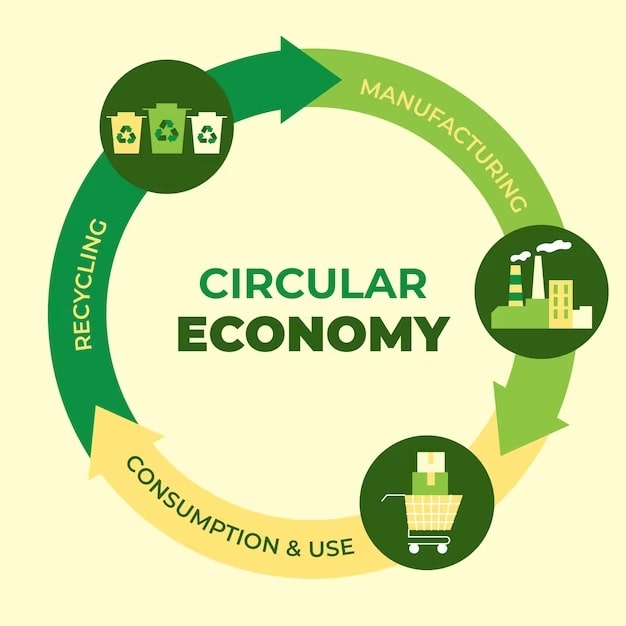Our current waste management system , the linear economy, works like a conveyor belt. We take materials from the earth, make products from them, consume, then throw them away, ebbing away earths’ finite resources. A circular economy, on the other hand, works quite differently. It closes the loop on the linear, take-make-throw away pattern. Underpinned by a progression to renewable energy and materials, the circular economy is a resilient system that is exemplary for business, people and the environment.
A circular economy is a model of production and consumption where items and products are re-used whenever possible rather than discarded. It tackles climate change and other global challenges like biodiversity loss, waste and pollution by decoupling economic activity from the consumption of finite resources. It is guided by three principles; Eliminate waste and pollution, through re-thinking product design. Circulate products and materials at their highest value, that is keeping materials in use either as products or raw materials. Lastly, Regenerate nature, by shifting from the take-make- waste pattern allowing natural processes and leaving room for nature to thrive.
Statistics show that only 7.2% of used materials are recycled back into our economies. “Why transform from the throw-away economy? My loyal clients prefer the latest gadgets, I must upgrade my products regularly to keep up!” businesses might ponder. Well, it is estimated that copper will be mined out globally by 2040 and without re-thinking product design, businesses will be affected by the rocketing copper prices. The linear economy has a significant impact on the environment, society and ultimately business profitability hence the need to close the loop.
A circular economy creates value. It reduces the cost of buying raw materials and making new products for businesses. As a result, Customers have access to products at lower prices. Most of all, the model lowers Green House Gas emissions, reduces landfills and contributes to cleaner water benefitting the environment and society. Let’s explore companies reaping value from a circular economy across various industries.
H&M, the world’s second largest fashion company has embarked on its circular journey by redesigning its entire value chain and operations. The Group has developed a circulator tool that supports the creation of products that can be kept in circulation, having been designed with sustainably sourced materials that are durable or recyclable. Through the Jeans Re-design project, H&M has made pieces that are timeless, easy to repair and age with a beautiful Patina. It is also exploring textile-textile recycling via partnerships with companies such as Infinite Fiber and Worn Again. The fashion house is piloting the Mint-care and Take-care initiative that will support customers in repairs prolonging the life of clothes. It also ensures its shop furnishings are recyclable. The group has managed to raise financing for its transition through a sustainable-linked bond (SLB). H&M already shows indications of achieving its circular economy goals having recycled or sustainably sourced 65% of its materials by 2021 against a target of 30% by 2030.
About 50% of the food that is grown in East Africa never makes it to the market due to poor roads, inadequate packaging and lack of cold storage. The result is that farmers’ resources and time are squandered, reducing their incomes leading to increased poverty and food insecurity. Agricycle has stepped in to work with small holder farmers globally to upcycle food that would otherwise be wasted. It manufactures and distributes solar dehydrator technologies that enable longer preservation of food, purchases the resulting products directly from cooperatives and creates brands to sell these products in global markets. The farmers benefit by selling more produce at higher prices.
Apeel is a company that works with nature to make food last longer. Apeel is a layer of edible, plant-based coating applied to fresh products such as Avocados that mimics and enhances the natural defenses of fruits and vegetables. This slows down the two main things that cause spoilage – water loss and oxidation. By increasing the shelf-life, the company prevents food wastage. This technique also designs out plastic waste as no man-made packaging is needed.
Sprite has begun its transition from green bottles to clear bottles in many markets to improve its value during recycling. In Southeast Asia for instance, clear PET bottles sell for an average of USD 84 per tonne more than colored bottles. Colored plastics are also harder to recycle and have much more limited use compared to clear plastics. Some sprite bottles are now being made from 100% recycled pet.
Transitioning towards a circular ecosystem can be challenging for SMEs, especially in Africa due to Limited Knowledge. Few SMEs know about the potential of circular economy and the strategies for implementing it. Sustainability consultants can, however, appropriately guide them through their transition by establishing a suitable strategy to a more circular economy. SMEs often struggle to access adequate finance to make the transition. With a well outlined transition strategy, SMEs stand a better chance of acquiring green financing.
Only through re-thinking product design to regenerate ecosystems instead of harming them can businesses become resilient and sustainable. It is therefore important for businesses to embrace cradle to cradle, Remaking the way they make things as the father of the Circular economy William Mcdonough put it.



